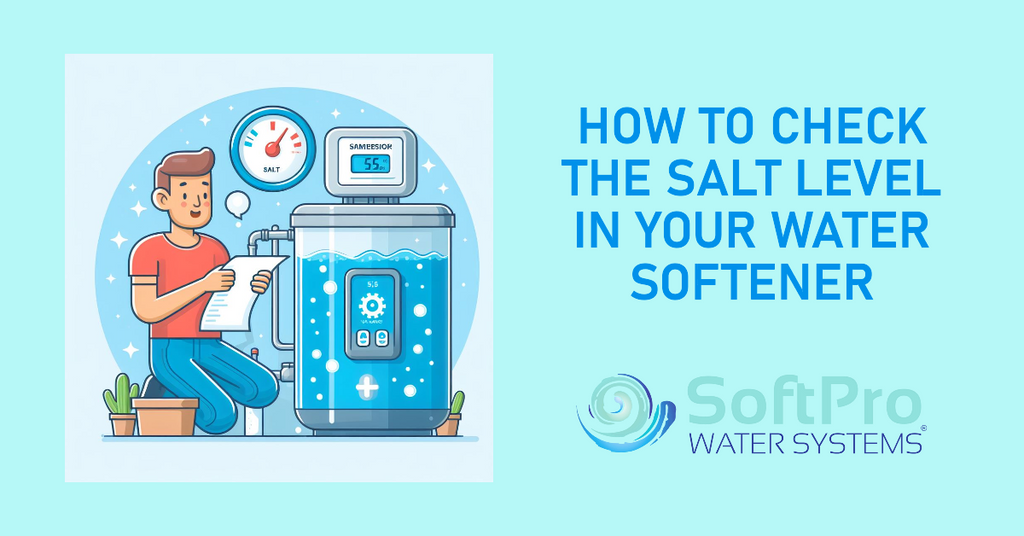Checking your water softener's salt level is a simple yet essential maintenance task to ensure your system keeps delivering soft water. Hard water, with its high mineral content, can leave spots on dishes, make laundry feel stiff, and create buildup in your plumbing. Fortunately, understanding how to check the salt level in your water softener eliminates these problems and keeps your water feeling luxuriously soft.
Understanding Your Water Softener's Brine Tank
The brine tank is the large, usually cylindrical tank located beside your water softener's resin tank. It's where the salt is stored that's crucial for the softening process. Inside the brine tank, salt is mixed with water to create a concentrated solution called brine. This brine solution plays a vital role in the water softener's regeneration cycle – the process that recharges the resin beads responsible for removing hardness minerals from your water.
How to Check the Salt Level
Here's a step-by-step guide to checking your water softener's salt level:
- Step 1: Locate the Brine Tank: Your brine tank is typically next to the main resin tank of your water softener.
- Step 2: Open the Lid: Carefully lift the brine tank's lid, being sure not to disturb the salt inside.
-
Step 3: Assess the Salt Level:
- Ideal Salt Level: Ideally, the salt should be visible a few inches above the waterline, filling the tank about halfway.
- Low Salt: If the salt is below the water or nearly gone, it's time to add more.
- Salt Bridges: Check for a hard, crusty layer of salt above the waterline. This 'salt bridge' can block water flow, so gently break it up with a long object like a broomstick.
Troubleshooting Common Salt Issues
Sometimes you might encounter issues with the salt in your brine tank. Here are some common problems and solutions:
- Salt Not Dissolving/Going Down: This is often caused by a salt bridge, humidity leading to clumping, or using the incorrect salt type. Break up any salt bridges, try switching to a different salt, and consult your water softener's manual for compatibility.
- Mushy Salt: Mushy salt at the bottom of the tank usually indicates low-quality salt with impurities. Switch to higher-purity evaporated salt for better results.
- Salt Level Not Changing Even After Adding: This could signal a problem with the brine tank float or an issue during the regeneration cycle. In this case, it's best to contact a water softener professional.
Choosing the Right Salt for Your Water Softener
The type of salt you use matters! Here's a breakdown of common options:
- Solar Salt: The most affordable and widely available option; suitable for most water softeners.
- Evaporated Salt: Offers higher purity, leaving minimal residue in your brine tank.
- Potassium Chloride: A sodium-free alternative, good for those on sodium-restricted diets. However, it may be less effective in areas with extremely hard water.
Factors to Consider When Choosing Salt
- Water Hardness: Consult a water hardness map or test your water to determine the severity of your hard water problem. You can also check information here - U.S. Geological Survey on water hardness
- Water Softener Recommendations: Your water softener's manual will suggest compatible salt types.
- Budget and Preferences: Balance your budget with your preferences for purity or sodium-free options.
Important Notes:
- Check Salt Levels Regularly: Aim to check your salt level about once a month to keep your water softener working optimally.
- Avoid Overfilling: The brine tank shouldn't be completely full of salt. Keep it around the halfway mark.
- Water Softener Brands: Popular brands like Morton Salt, Culligan, and Kinetico offer various types of water softener salt.
- Consult a Professional: For complex salt issues or water softener malfunctions, always consult a qualified professional.
FAQs
How often should I check the salt level in my water softener?
For optimal performance, check your water softener's salt level at least once a month. If you have very hard water or use a lot of water, you may need to check more frequently.
What happens if my water softener runs out of salt?
If your water softener runs out of salt, it won't be able to regenerate its resin beads. This means you'll start to notice hard water symptoms, like spotty dishes, dry skin, and less effective cleaning.
My water softener salt isn't going down. What's wrong?
The most common reason is a salt bridge – a hardened crust of salt blocking water flow in the brine tank. Break up the salt bridge and check if the level starts going down during the next regeneration cycle. Other causes could be a faulty brine tank float or regeneration issues.
Can I use any type of salt in my water softener?
While various salt types exist (solar, evaporated, potassium chloride), it's crucial to use the type recommended by your water softener manufacturer. Using the wrong salt can lead to residue buildup, clogging, or inefficient softening.
Maintaining Your Water Softener: Key Insights
Understanding your water softener's salt requirements is essential for ensuring consistently soft water throughout your home. Here's a recap of the crucial points covered in this article:
- Salt Level Matters: Regularly checking your water softener's salt level (approximately once a month) is a simple task with a big impact on the system's effectiveness.
- The Role of the Brine Tank: Your softener's brine tank houses the salt that creates the brine solution used to recharge the resin beads responsible for removing hardness minerals.
- Troubleshooting Salt Issues: Salt bridges, mushy salt, and salt levels not changing are common problems with straightforward solutions.
- Choosing the Right Salt: The type of salt you use depends on your water hardness, softener model, and personal preferences.
Ready to experience the benefits of soft water?
Explore SoftPro Water Systems' range of innovative water softeners and find the perfect solution for your home. Contact us today for personalized advice and a free water hardness test! Visit us at https://www.softprowatersystems.com


















![Aldex Premium 10% Cross Link Resin for Water Softener [High Capacity]-SoftPro® Water Systems](http://www.softprowatersystems.com/cdn/shop/files/Aldex_10_Cross_Link_Resin_Premium_High_Capacity_for_Water_Softener_600x.jpg?v=1735853599)





















